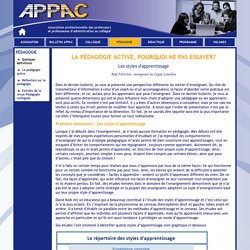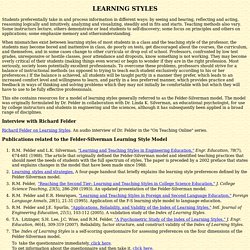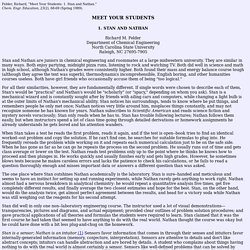

Ce que la recherche nous dit sur les styles d’apprentissage (ou retour sur un mythe tenace) La recherche sur les styles d’apprentissage, dont les origines remontent aux années 1930, a vu le jour en Europe occidentale et aux États-Unis et a réellement pris son essor depuis cinq décennies. Felder & Soloman: Learning Styles and Strategies.
Richard M.

Felder Hoechst Celanese Professor of Chemical Engineering North Carolina State University Barbara A. Soloman Coordinator of Advising, First Year College North Carolina State University Active learners tend to retain and understand information best by doing something active with it--discussing or applying it or explaining it to others. Reflective learners prefer to think about it quietly first. Everybody is active sometimes and reflective sometimes. How can active learners help themselves? Felder stratégies. Retour sur le Cycle de Kolb.
Les styles d'apprentissage. Les styles d'apprentissage Réal Petitclerc, enseignant au Cégep Limoilou Dans le dernier bulletin, je vous ai présenté une perspective différente du métier d’enseignant.

Du rôle de transmetteur d’information à celui d’un coach ou d’un accompagnateur, la façon d’aborder notre pratique est bien différente, et ce, autant pour les apprenants que pour l’enseignant. Dans ce dernier bulletin, je vous ai présenté quatre dimensions qui ont le plus influencé mon choix d’adopter une pédagogie ou les apprenants sont plus actifs. Ce nombre n’est pas limitatif, il y a bien d’autres dimensions à considérer, mais je me vais me limiter à celles qui m’ont permis de modifier mon approche.
Première dimension : Les styles d’apprentissage Lorsque j’ai débuté dans l’enseignement, je n’avais aucune formation en pédagogie. Il m’a fallu un certain temps pour réaliser que nous n’apprenons pas tous de la même façon. ILS Validation(IJEE) Tableau 7 profil apprentissage. Test psychologique : Mon résultat à l'Indice des styles d'apprentissage. Votre score est de 5b (tendance modéré le mode réflexif).

Les apprenants actifs ont tendance à préférer apprendre en étant en action : mettre en application, expérimenter, discuter, expliquer à d'autres… Les apprenants réflexifs ont tendance à préférer d'abord penser tranquillement de façon solitaire ou avec un(e) partenaire habituel. Tout le monde est parfois actif et parfois réflexif. Chaque mode a ses avantages et ses inconvénients. En agissant toujours avant de penser, une personne peut se lancer prématurément et connaître des difficultés non anticipées alors qu'en prenant trop de temps pour penser, les choses peuvent ne jamais être faites.
Votre score est de 5a (tendance modéré le mode sensoriel). Les apprenants qui privilégient le mode sensoriel ont tendance à préférer apprendre des faits et résoudre les problèmes selon des méthodes bien établies ; à ne pas aimer les complications et les surprises. Tout le monde est parfois sensoriel et parfois intuitif. Ce que la recherche nous dit sur les styles d’apprentissage (ou retour sur un neuromythe) Litzinger Validation Study. ILS Validation(IJEE) Learning Styles. Students preferentially take in and process information in different ways: by seeing and hearing, reflecting and acting, reasoning logically and intuitively, analyzing and visualizing, steadily and in fits and starts.

Teaching methods also vary. Some instructors lecture, others demonstrate or lead students to self-discovery; some focus on principles and others on applications; some emphasize memory and othersunderstanding. When mismatches exist between learning styles of most students in a class and the teaching style of the professor, the students may become bored and inattentive in class, do poorly on tests, get discouraged about the courses, the curriculum, and themselves, and in some cases change to other curricula or drop out of school. Professors, confronted by low test grades, unresponsive or hostile classes, poor attendance and dropouts, know something is not working.
Interview with Richard Felder Richard Felder on Learning Styles. Return to Dr. RANDOM THOUGHTS - MEET YOUR STUDENTS: 1. STAN AND NATHAN. Felder, Richard, "Meet Your Students: 1.

Stan and Nathan. "Chem. Engr. Education, 23(2), 68-69 (Spring 1989). Richard M. Stan and Nathan are juniors in chemical engineering and roommates at a large midwestern university. For all their similarities, however, they are fundamentally different. When Stan takes a test he reads the first problem, reads it again, and if the test is open--book tries to find an identical worked--out problem and copy the solution. The one place where Stan outshines Nathan academically is the laboratory. Stan did well in only one non--laboratory engineering course. Stan is a sensor; Nathan is an intuitor.(1) Sensors favor information that comes in through their senses and intuitors favor internally-generated information (memory, conjecture, interpretation).
Postscript: 15 years later. Matters of Style. Bill Gates, Warren Buffett, and Oprah Winfrey All Use the 5-Hour Rule. In the article "Malcolm Gladwell Got Us Wrong," the researchers behind the 10,000-Hour Rule set the record straight: Different fields require different amounts of deliberate practice in order for someone to become world-class.

If 10,000 hours isn't an absolute rule that applies across fields, what does it really take to become world class in the world of work? Over the past year, I've explored the personal histories of many widely admired business leaders, including Elon Musk, Oprah Winfrey, Bill Gates, Warren Buffett, and Mark Zuckerberg, in order to understand how they apply the principles of deliberate practice. What I've done does not qualify as an academic study, but it does reveal a surprising pattern. Many of these leaders, despite being extremely busy, have set aside at least an hour a day (or five hours a week) over their entire career for activities that could be classified as deliberate practice or learning.
I call this phenomenon the five-hour rule. 1. These two are not alone. Apprendre par soi-même aujourd'hui: Les nouvelles modalités de l ... - Marc Nagels, Philippe Carré. Personal Learning MOOC Week Six Friday Hangout.